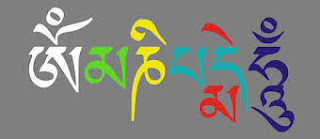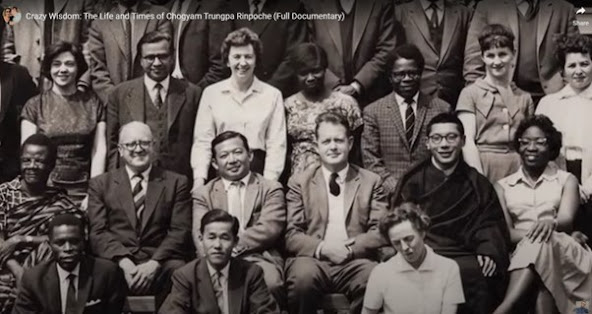Colours of the spinning mantra
Approximate script, with some variations and possible errors:
Hello good people. Welcome, or welcome back, to the Double
Dorje podcast. I’m Alex Wilding, and today will be looking at all the rainbow
colours of the mantra, sticking mainly with the famous Mani, as well as looking
how they go round and round and round and round.
In an earlier episode we looked a bit at the meaning of the
Mani, and a couple of tunes that we might use for it. Today I want to look at
some of its visual aspects, its colours, and its connection to the “six
worlds”. The Mani is a particularly good example to use for this for three
reasons: it is beautiful, it is popular, and it is accessible to people who
haven’t received an appropriate empowerment. No rules need to be broken! Of
course, if you can get an empowerment for this you certainly should. I’m not a
great fan of online empowerments – perhaps they sort of work, but it all seems
like very thin gruel – but a Chenrezi empowerment should be easier to find than
some others.
You could perhaps just get a “reading transmission” (lung),
you can get an empowerment for some of the common sadhanas, and on rare
occasions it is possible to get an empowerment for Chenrezi as your “yidam”,
that is to say your personal, precious deity that you keep close to your heart.
To my knowledge, the previous Kalu Rinpoche gave an empowerment on this sort at
the National Liberal Club in London back in 1977, along with some fairly extensive
explanations. I therefore rather imagine that he gave this at other places and
times. If any students of his from back then are listening, they may know.
I have to confess that I dip a toe into the dark and swirling
waters of Reddit on a fairly regular basis. Time and again, a question is asked
in both Buddhist subreddits and language subreddits, where a picture is shown
and the poster asks, “can anybody tell me what this says?” Now I haven’t
measured it (I’m not THAT much of a nerd) but I could bet that half the time
the answer is that it is a representation of our mantra, OM MANI PEME HUM. Some
of the images are beautiful, but it must be admitted that in many other cases
the script is god-awful, and has rather obviously been written by somebody with
no knowledge of Tibetan script. I have a mental picture of it pinned up on the
wall of the backstreet workshop where low-quality dharma-tat is churned out for
sale in the Buddhist tourist traps in North India, Nepal, Sikkim or Bhutan, and
the poor semi-literate craft worker has to copy it onto the product at speed.
So be warned – if you’re like most people, you won’t be able to judge the
quality yourself very easily, so if you are spending more than pennies for such
a souvenir, get somebody knowledgeable to give you an opinion.
One illustration you quite often see, and the quality here
can just as well be good as it can be bad, shows the six syllables of the
mantra arranged on the six petals of a lotus, often having the seed syllable of
Chenrezi, HRIH in Latin writing, preferably with a bar over the letter I to
show that it is lengthened. This is the arrangement where you are most likely
to see the syllables of the mantra shown in colour. This lifts the symbolism to
a new level.
I have in front of me a translation by Ken McLeod of a text
called “A Continuous Rain To Benefit Beings” written by the 15th
Karmapa, Kakhyab Dorje – I’ll include those names in the list of words that you
might like to look up to be found on the description of this episode at the
podbean site. Unfortunately this small book was privately published by a centre
in Canada so there is nothing like an ISBN number to help you out. Having just
said that I did an Internet search, and I see that there are copies available
here and there, including one on Amazon for the astonishing price of about $80.
As I live in Italy, there would be a $40 delivery charge as well, but even
without that I would recommend any potential buyer to look elsewhere.
The thing is, this would be an excellent resource for anyone
who wants to learn more details about the Chenrezi meditation practice,
although the subject matter that Kakhyab Dorje assembled here is widely enough
disseminated in Tibetan Buddhist literature that I’m sure there are other
effective sources.
Starting from the most obvious point, there are six syllables
in the mantra, and visualisation aligns them with the “six worlds”. Eyebrows
may now be raised, and some will be wondering what ever the six worlds are. In
pictorial form, this is something else very commonly seen in the context of
Tibetan Buddhism. You will often see a painting of what looks like a wheel, and
is indeed meant to be a wheel, with six spokes and six spaces in between them.
The topmost space shows a picture of the realm of the gods, upper left the
realm of humans, upper right the demigods, lower left the animals lower right
the hungry spirits and at the bottom the hell realms. These are held to be the
main kinds of rebirth from which we come and to which we go if we are not
awakened. This wheel of life picture generally has a lot more detail and once
again could itself be a subject for another episode.
OM, the first syllable, then is white. The realm of the gods
is a delicious paradise, but in the Buddhist view is in the end unsatisfactory,
precisely because it does come to an end. As with the other syllables, this OM
represents the power of enlightened energy appearing in this realm, leading the
beings who are in it toward the awakened state.
Moving on, MA is green, representing patience and leading the
demigods towards the enlightened or awakened state. NI is yellow, guiding human
beings to liberation, while PAD or PE is sky-blue guiding animals at the
darkness of ignorance towards awakening. ME is red, and appears to the hungry
ghosts guiding them to awakening, while finally the HUNG is black or extremely
dark blue, and represents the light of awareness appearing even in the depths
of suffering.
This is just a little taste of explanation, and if you are
interested in it then you can study it in far more detail. Whole books have
been written in both Tibetan and English on this subject. At any rate, we now
have a handle on the significance of there being six syllables and of them
having the particular colours that they do.
But how do they turn? How do they spin? The answer is in fact
quite simple, but many, many times I have seen students going cross eyed trying
to figure this out. I do remember Thrangu Rinpoche, back in the days when a
handful of low-grade students like myself could talk to him in a converted
living room in a terraced house in Edgbaston, explaining it to us with the aid
of mantras written on little strips of paper. So if you know this, please do
skip forward, as I’m going to put it in terms that you may find painfully
simple. If even one confused person finally gets it straight, then it will have
been worth it.
Because there is no video here, you may need to listen
very carefully!
The way that the Mani mantra spins is an example of the most
common arrangement. I ask you to picture yourself in a fairground standing in
front of a merry-go-round. It’s a small merry-go-round with just six wooden
horses. The operator’s cab in the middle, doesn’t turn, and this is where the
seed syllable, the HRIH is positioned, standing upright and facing us. The
horse right in front of us is facing to our left, because when it starts, the
merry-go-round is going to turn clockwise. We place our first syllable, the
white OM, standing upright on its saddle, facing out towards us. Let the
merry-go-round advance a little, so that the OM has moved off a bit to the
left, and on the saddle of the second horse we place the green MA, again
standing upright and facing out towards us. We continue, adding the syllables one
at a time to the next four horses, all of the syllables facing out towards us
as they fill up the merry-go-round. One more move and the OM is facing us
again, and we will see that the mantra is written from right to left, like most
scripts do, going anticlockwise around the merry-go-round from OM to HUM, and
as the wheel now starts turning smoothly, we can read the mantra in a perfectly
natural way as the syllables go by: OM MA NI PE ME HUM, OM MA NI PE ME HUM, OM.
Summarising it yet again: the mantra syllables are standing upright, facing
outwards, the mantra is written anticlockwise, while the merry-go-round turns
clockwise so it is easy to read. Until it spends too fast for that, but that’s
another matter.
If you have that clear, then it should be easy to grasp that
some mantras turn the other way. Often, although not always, this is the
situation with female deities, dakinis and so on. To continue explaining in
this painful level of detail, we now need to imagine ourselves in the operators
cab rather than standing in front of the merry-go-round. The horses have to be
turned 180° to face the other way – notice that this means that as before,
because we are now in the operator’s cab, the horses face to our left. We place
the first syllable on the saddle of the first horse, let the merry-go-round
turn one place anticlockwise, put the second syllable on the second saddle and
continue for as many horses or syllables are necessary. Now when it turns, we
have the mantras standing upright, facing inwards, the writing proceeds
clockwise around the merry-go-round but the horses turn anticlockwise and, as
we are watching here from the operator’s cab, it is easy to read the mantra as
it goes by.
If you’re new to this, that might
sound complicated, but take it steady and I do believe you’ll see that it’s
fairly simple.
As with all of these things, specific
instructions may well override what is usual. I know, for instance, an
important guru yoga in which the deity, who is male, has a mantra that faces
inwards like the second merry-go-round above, an orientation more common with
female deities. And in this case the mantra wheel, as it were, does not turn –
it remains stationary just like the seed syllable in the centre. Specific
instructions rule!
So that’s it for today. Don’t forget to like, subscribe,
share, tell your friends, whatever – and remember that what goes around, comes
around! Om mani…..




Comments
Post a Comment